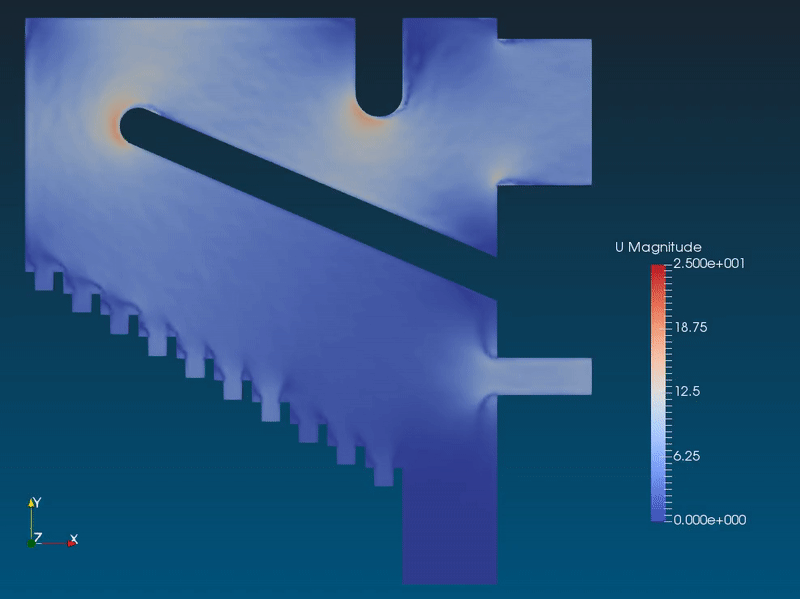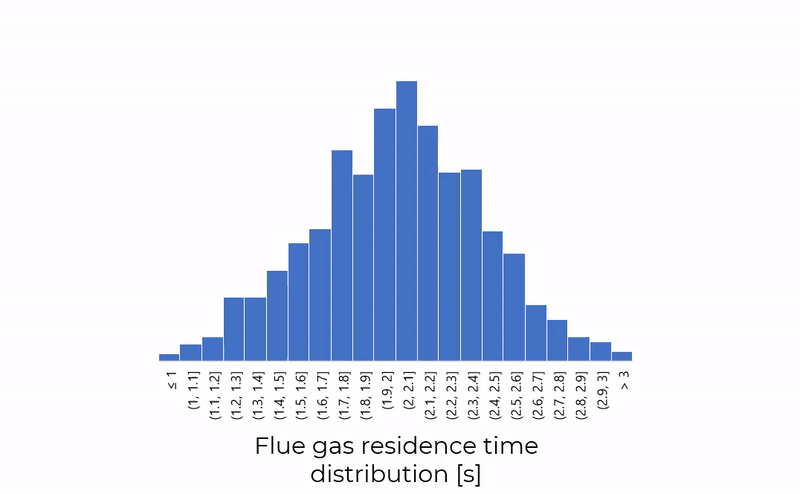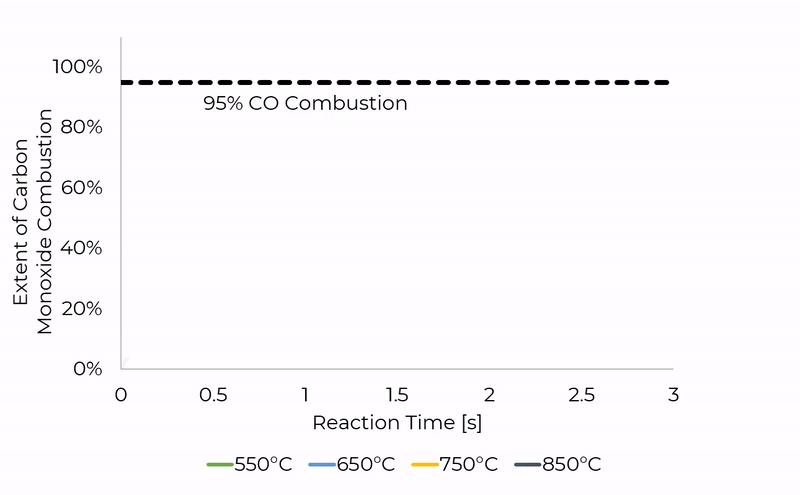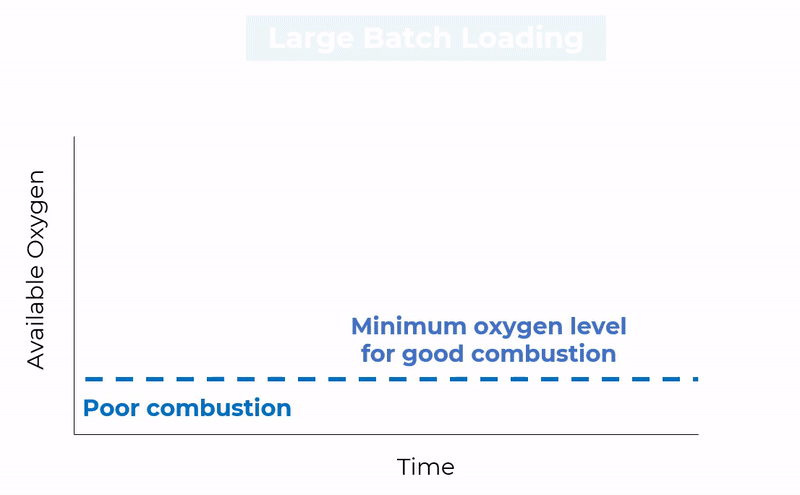Understanding and Improving Incinerator Combustion Performance
Combustion performance is often discussed with reference to the three-Ts of combustion. They are: Time, Temperature and Turbulence (with oxygen). What is often implied is that if the three-Ts are sufficiently represented in an incinerator, then combustion performance should be satisfactory. However, the history of flue gasses leaving an incinerator cannot be characterised by a single temperature, residence time, or oxygen concentration – rather they are better described by a distribution of residence times, temperatures, and oxygen concentrations (see What is Incineration?).
Strict modern air emission limits mean that if even only a small portion of flue gas fails to meet the correct combination of temperature, mixing with oxygen, and residence time, then emission limits will may not be met.
We will now take a closer look at the aspects affecting incinerator combustion performance, and some strategies we could potentially apply to improve it.
Residence time
Residence time refers to the time that packets of flue gas spend travelling through the incinerator before being expelled. For effective combustion to occur, the fuel and oxygen require sufficient residence time at appropriate conditions of temperature and oxygen concentration to react completely. If residence time is insufficient, combustion will be incomplete – resulting in poor emissions. Figure 1 shows how the development of flow paths through a step grate furnace can lead to a distribution in flue gas residence times instead of a single representative residence time. Figure 2 shows an example of a residence time distribution for discrete packets of flue gas travelling through an incinerator. While most chamber gases may have reached the required combination of conditions, some small number of packets may not have, resulting in failure to meet emission limits.

Figure 1: Example of flow patterns in a step grate furnace

Figure 2: Example of flue gas residence time distribution through an incinerator
The average residence time through a chamber can be estimated according to the following formula:

The volumetric flow rate of flue gas is proportional to the amount of waste being combusted. It can therefore be deduced that changes in waste feeding rates result in changes in flue gas residence time. With the volume of an incinerator chamber typically fixed at the design stage, the only practical method for operators to increase the residence time of combustion gases would be to operate the incinerator at a reduced capacity, i.e. feeding waste at a reduced rate. This would decrease the volumetric flow rate of flue gases generated and therefore increase their residence time (see equation above). However, operating the incinerator at a reduced capacity would likely increase operating costs as the operating hours would need to be increased accordingly to get through burning all the waste.
It is beneficial to feed incinerators at a steady feed rate as specified by the manufacturer to ensure that the gases maintain a steadier residence time in the incinerator.
The effective residence time is reduced if flue gas is presented with opportunity to shortcut out of the chamber. It is therefore crucial that an incinerator be properly designed to both prevent shortcutting and ensure sufficient residence time for the expected volumetric flow rate of flue gas.
Ensuring sufficient residence time for combustion inside your incinerator ensures improved combustion efficiency and emissions. This is because the gases are afforded sufficient time to completely react, moreover the reduced flue gas velocity would typically improve settling chamber performance for particulate removal.
Temperature
The second crucial parameter for good combustion – is temperature. To demonstrate the importance of temperature, we will consider the destruction of a prominent pollutant, carbon monoxide (or CO). Carbon monoxide is formed during the incomplete oxidation of carbonaceous material:

To reduce emission of toxic carbon monoxide to the environment, it must be further oxidised (or combusted) to produce carbon dioxide:

The rate of carbon monoxide combustion is very sensitive to temperature and the presence of oxygen. Figure 3 shows how the effective reaction time required to reach 95% carbon monoxide combustion can be drastically reduced by increasing the temperature – if sufficient oxygen is present.

Figure 3: Effect of temperature in reaction time required for 95% combustion of carbon monoxide
At temperatures below 650°C, carbon monoxide oxidation very slow.
What complicates the matter is that incinerators are rarely at a single uniform temperature that is accurately represented by the thermocouple measurement. Different temperature zones exist which include hotter and cooler spots inside the incinerator. Incinerators should therefore be designed to prevent the formation of both excessive hot spots, which could cause wear on the refractory, and cool spots, which could lead to poor combustion performance.
To increase the likelihood of all flue gas packets reaching the temperature required for sufficient combustion of carbon monoxide and other pollutants, incinerators are typically operated in the temperature range of 850°C to 1050°C.
Higher incinerator temperatures have the additional advantage of accelerating combustion of waste to ash.
Turbulence and Oxygen
The third and final component required for good combustion is the presence of oxygen and good mixing. Turbulence (or mixing) is a concept that is well understood, but not easily measured or quantified in practice.
Combustion reactions require oxygen. Oxygen is provided for combustion through combustion air which is blown in at appropriate points along the combustion chamber. The combustion fan should be sized properly to provide enough oxygen at a velocity that ensures good mixing. If insufficient oxygen is available for good combustion, then combustion is incomplete, leading to dark smoke and high levels of carbon monoxide, particulate, and other pollutants in resulting smoke.
Figure 4 demonstrates the effect of load size on the available oxygen in a combustion chamber. When a single large load is introduced into the combustion chamber, it starts to combust and rapidly depletes the available oxygen, leading poor combustion. This can typically be visually observed as black smoke bellowing from the chimney. The oxygen level slowly recovers as the waste load burns away.
When smaller more frequent loads are fed in line with specified incinerator capacity, the available oxygen remains sufficient to sustain good combustion. In this case, the available oxygen can recover quicker, as instantaneous oxygen demand is reduced. This demonstrates the operational advantage of feeding small frequent batches as opposed to large infrequent batches. It also shows that overfeeding an incinerator with large batches will lead to poor combustion. Small frequent batch loading also reduces high temperature spiking typically associated with feeding of large batches. Eliminating temperature spikes and thermal cycling improves the longevity of incinerator refractory.

Figure 4: The effect of load size on oxygen availability in an incinerator
Turbulence or good mixing ensures that the oxygen present in the chamber is brought into contact with waste, fuel, and pollutants so that oxygen is available where it is needed for the combustion reactions to occur. Turbulence in an incinerator is usually fixed at the design stage through aspects such as the number and position of burners, combustion air velocity and distribution, waste feeding mechanism, and chamber design.
Conclusion
We can see that good incinerator combustion depends on a host of factors that need to be simultaneously satisfied. In some cases, when the requirements for good combustion are not met, it may due to an incorrectly sized incinerator or even poor incinerator design. However, in many cases
simple operator intervention can significantly improve incinerator combustion performance. Below is a table summarising simple operator interventions that may improve incinerator combustion performance, leading to emission improvements.
Please consult with your manufacturer prior to implementing any of these changes.
Temperature
- Temperature setpoint – Ensure that chamber temperature is high enough for good combustion. An appropriate temperature for many waste types is typically in the range of 850 – 1050°C.
- Thermocouples – Check that thermocouples are properly located and in good working condition. If a thermocouple is located directly in a burner flame, then the temperature measurement is likely to overestimate the actual chamber temperature.
- Blending of waste – If wet waste is being fed, such as food, it is advantageous to blend it with dry, more combustible waste prior to feeding. The dry waste will provide some of the heat required to burn the wet waste, therefore reducing the burden on the burners for energy. This will also reduce large drops in temperature usually associated with the feeding of wet waste.
- Burners – Check that the burners are firing properly and are serviced as required. Using clean fuel and ensuring fuel filters are in good working order can improve burner performance.
Time
- Feed rate – Individual incinerators typically have a fixed rated throughput (or range thereof) for a specific waste type specified by the manufacturer. Exceeding this throughput reduces the effective residence time of combustion gases through the incinerator. It is therefore crucial that the operators do not exceed the rated throughput of the incinerator.
Turbulence and Oxygen
- Combustion fan – Check that the combustion fan is working properly, and the air distribution manifold (if present) is leak free, and clean. Depending on incinerator design, combustion air flow can often be controlled manually using dampers. In this case, ensure that these dampers are set properly according to manufacturer’s instruction.
- Load sizes – It is generally preferrable to feed small frequent batches as opposed to larger infrequent batches. Smaller feed sizes lead to a lower more constant oxygen demand as well as a more uniform residence time for combustion gases. This tends to produce better combustion performance compared to large batch loads which may exhaust the available oxygen from the combustion fan, leading to
Author: Willem Rossouw
Engineering Manager @ Macrotec
